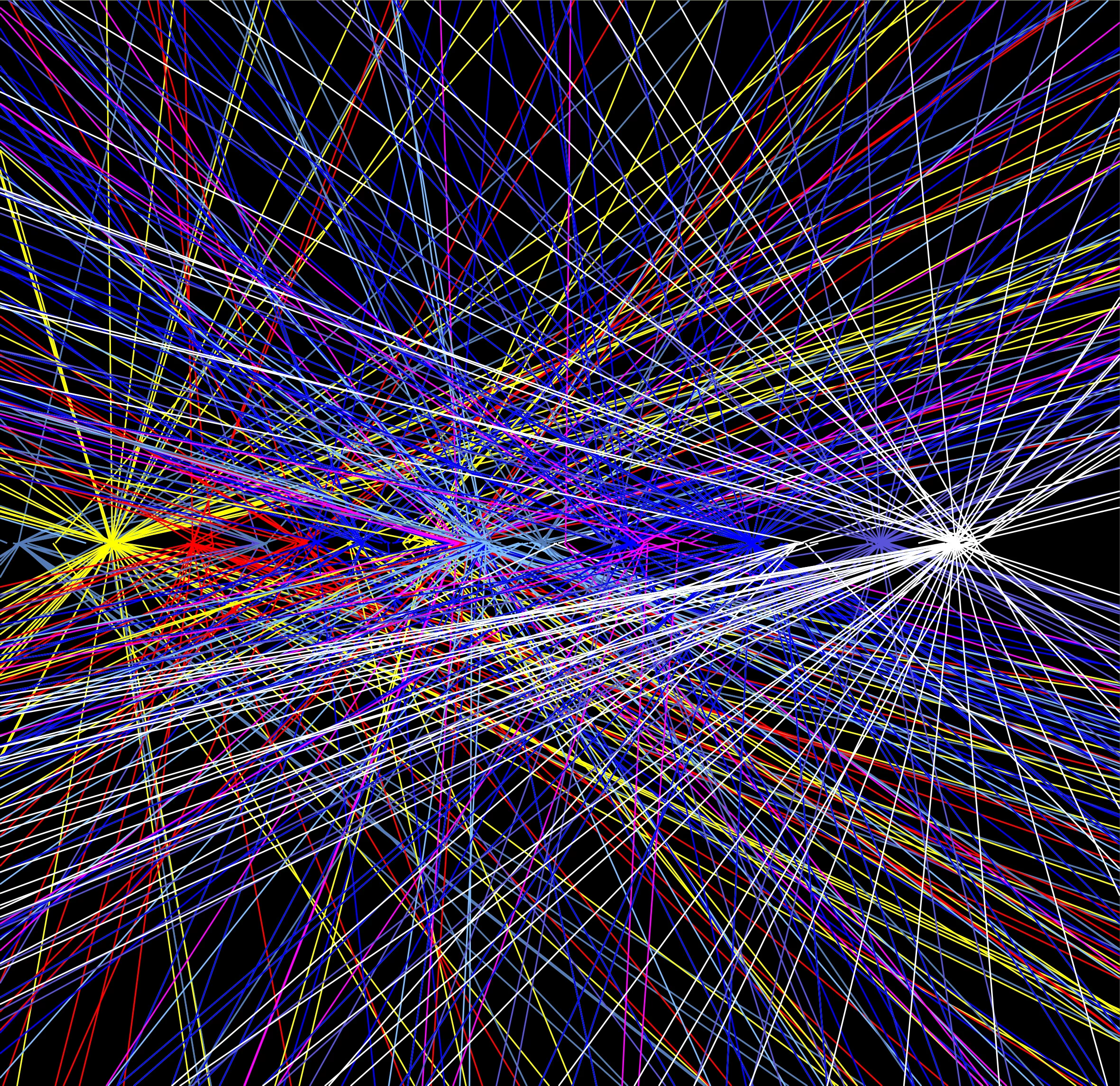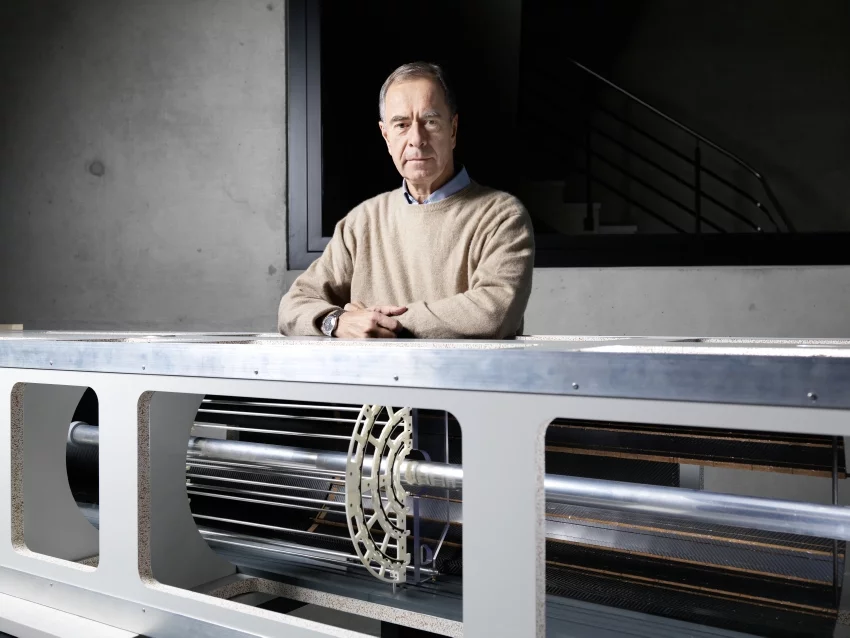Higgs Particle Found announced the media triumphantly in July 2012 – a sensational result that generated great public excitement, and which provides a reason for elementary particles to have mass. But for Roland Horisberger, particle physicist at PSI, this was a premature conclusion: It will take at least another five years before we can be sure of that. However: We have certainly discovered the existence of another fundamental particle in Nature.
There is a long checklist of properties that the Higgs particle should have according to theory, and it will take a lot of experimental work to verify each one of them. Whatever the findings – whether this is the original Higgs boson, or only one of the theoretical Higgs-like particles – one can surely put a tag on them that reads PSI inside .
PSI researchers have developed and built the pixel detector that allows the scientists to see
electronically when and where a particle has flown past. The data measured thereby are indispensable for the calculations that will show whether or not a real Higgs particle has been observed.
Key element of the CMS detector developed at PSI
The pixel detector is the innermost part of the CMS experiment at the CERN comprising various sub-detectors nested into each other – rather like Russian Matryoshka
dolls. The pixel detector itself is made up of a huge number of tiny microchips developed at PSI. While the outer components of the CMS experiment are about 16 metres in diameter, the pixel detector has a radius of only about 16 cm. The only object to pass through the centre of the detector is the vacuum beampipe of the LHC accelerator. In the beampipe, two tiny bunches of protons, travelling toward each other at almost the speed of light, collide head-on. These hefty collisions generate countless new particles, which fly apart in all directions. Among them, one might occasionally find a Higgs particle. But one shall never actually see it. After an inconceivably brief lifetime it decays into other particles well before reaching the detector.
Our world is made up of tiny building blocks – elementary particles. The goal of particle physicists is to determine which particles exist, and to find out how they interact to form our world. Many possible particles are not actually part of our world because they decay into other particles after an extremely short lifetime. They can however be generated and investigated in experiments – which gives an indispensable insight for a full understanding of the micro-world.
Beginning in the 1960s, theoretical physicists have been continuously developing the standard model of particle physics.In simple terms, the standard model can be described as a calculation procedure for determining which particles theoretically exist and what properties they have. A key aspect of this model is the so-called Higgs mechanism, postulated in 1964 by the British physicist Peter Higgs. Calculating particle properties according to the standard model without the Higgs mechanism, results in particles with no mass, which obviously cannot be true. In order to arrive at the correct values for particle mass, the Higgs mechanism is therefore necessary. However, it also dictates that there must be an additional particle as well: the Higgs particle.
Except for the Higgs, all particles predicted by the standard model have been reliably observed. Finding this particle is however not the end of the road for particle physics –astronomers observe a lot of dark matter in the universe that must comprise as yet unknown particles.
Looking for a needle in a haystack
These particles, however, can be observed in the detector, but finding their traces among those of thousands of particles created in the proton collisions is like finding a needle in a haystack. This feat is made possible by the pixel detector’s extremely high precision as well as a host of computer programs developed and written at PSI. They enable the calibration of the detector and the precise determination of its position within a thousandth of a millimetre. Other PSI programs enable the exact positions of proton-proton collisions to be determined – this allows the particles’ trajectories to be traced back to their origins, and therefore the determination of whether they might originate from the same point. The quality of pixel data for track reconstruction is so incredibly high today – undreamed of with the detector technologies of the past
, says Horisberger.
The other sub-detectors in the Matryoshka
provide additional data on the particles observed, so that in the end one not only knows their trajectories, but also their speed and type. With this information one can determine the original characteristics of each particle – its mass, for example – and above all whether it could actually have been a Higgs particle. Observing decays
For this purpose, it is necessary to observe how the particle has decayed. A Higgs particle can decay in various ways – in some cases, particles of one kind are produced in the decay, in other cases particles of other kinds. This process is not entirely arbitrary, however: the frequency of any Higgs particle decay path can be calculated. Michael Spira of the PSI Particle Physics Laboratory’s theory group has taken on this task, and through extremely complex calculations has determined precisely how often any decay path of the Higgs particle is expected to occur according to current theory. All one has to do now, in principle, is to observe the various modes of decay in the experiments. These observations can then be compared with Spira’s calculations.
But in practice that is not so simple – the difficulty of observing the various modes of decay differs widely. Up to the summer of 2012, the data collected for the Higgs particle discovery has revealed a decay into four muons only five or six times, but a decay into two photons (light particles) about 150 times.
After an interruption during 2013/14, the LHC accelerator will likely have measured about ten times more Higgs data by the end of 2016. Then one will see if experimental observation actually confirms that more Higgs particles are generated than predicted by Spira’s calculations, and, consequently, whether one has to find an explanation for this unexpected phenomenon. At any rate, the situation remains exciting. Not least for the PSI researchers, who are crossing their fingers along with the entire particle physics community. They are continuously improving their data evaluation software for the pixel detector and are already considering the successor to the current pixel detector: The PSI group has initiated a project for installing an upgraded pixel detector in the
CMS experiment by February 2017.
Away from the public eye on the Higgs, Urs Langenegger’s small research team within the PSI pixel group is focusing on a different investigation that uses the CMS data to find an answer to the question as to whether any new laws of physics exist beyond the current Higgs theory.
This shows that there may be more than one needle in the haystack. It goes without saying that here again, the pixel detector data points are decisive for the outcome
, emphasizes Horisberger.
Text: Paul Piwnicki
Additional Information
- Technology from the Paul Scherrer Institute detects proton collisions at unprecedented levels of energy
- Laboratory for Particle Physics, http://www.psi.ch/ltp
- High Energy Physics, http://www.psi.ch/ltp/high-energy-physics
- Warten auf den richtigen Zerfall (only in German, Fenster zur Forschung 01/2012)


